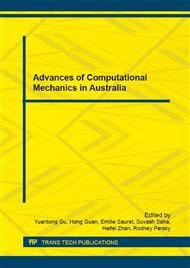[1]
R.I. Borja and S.S. Kishnani, On the solution of elliptic free-boundary problems via Newton's method, Comput. Methods Appl. Mech. Eng., 88: 3 (1991) 341-361.
DOI: 10.1016/0045-7825(91)90094-m
Google Scholar
[2]
H. Zheng, H.C. Dai, and D.F. Liu, A variational inequality formulation for unconfined seepage problems in porous media, Appl. Math. Model., 33: 1 (2009) 437-450.
DOI: 10.1016/j.apm.2007.11.012
Google Scholar
[3]
J. -P. Bardet and T. Tobita, A practical method for solving free-surface seepage problems, Comput. Geotech., 29: 6, (2002), 451-475.
DOI: 10.1016/s0266-352x(02)00003-4
Google Scholar
[4]
M.J. Kazemzadeh-Parsi and F. Daneshmand, Unconfined seepage analysis in earth dams using smoothed fixed grid finite element method, Int. J. Numer. Anal. Methods Geomech., 36: 6 (2012) 780-797.
DOI: 10.1002/nag.1029
Google Scholar
[5]
R. de Boer, Theory of Porous Media. Berlin, Heidelberg: Springer Berlin Heidelberg (2000).
Google Scholar
[6]
W. Ehlers and J. Bluhm, Eds., Porous Media. Berlin, Heidelberg: Springer Berlin Heidelberg (2002).
Google Scholar
[7]
D.M. Pedroso, A consistent u-p formulation for porous media with hysteresis, Int. J. Numer. Methods Eng., 101: 8 (2015) 606-634.
DOI: 10.1002/nme.4808
Google Scholar
[8]
D.M. Pedroso, A solution to transient seepage in unsaturated porous media, Comput. Methods Appl. Mech. Eng., 285 (2015) 791-816.
DOI: 10.1016/j.cma.2014.12.009
Google Scholar
[9]
D.M. Pedroso, D. Sheng, and J. Zhao, The concept of reference curves for constitutive modelling in soil mechanics, Comput. Geotech., 36: 1-2 (2009) 149-165.
DOI: 10.1016/j.compgeo.2008.01.009
Google Scholar
[10]
D.M. Pedroso, The subloading isotropic plasticity as a variable modulus model, Comput. Geotech., 61 (2014) 230-240.
DOI: 10.1016/j.compgeo.2014.05.013
Google Scholar
[11]
D.M. Pedroso and D.J. Williams, A novel approach for modelling soil-water characteristic curves with hysteresis, Comput. Geotech., 37: 3 (2010) 374-380.
DOI: 10.1016/j.compgeo.2009.12.004
Google Scholar
[12]
D.M. Pedroso and D.J. Williams, Automatic calibration of soil-water characteristic curves using genetic algorithms, Comput. Geotech., 38: 3 (2011) 330-340.
DOI: 10.1016/j.compgeo.2010.12.004
Google Scholar


